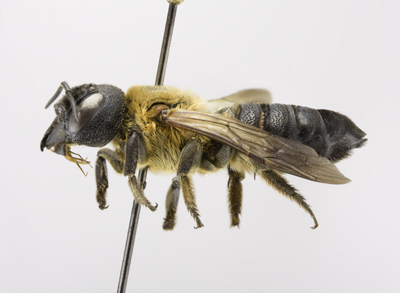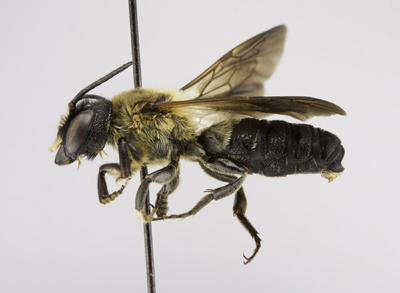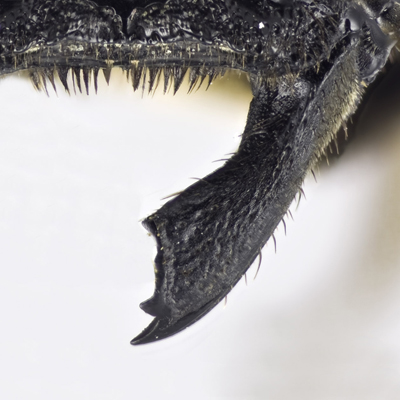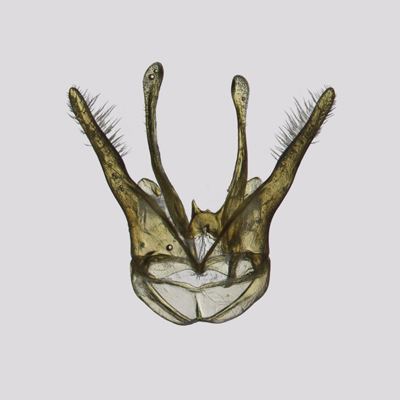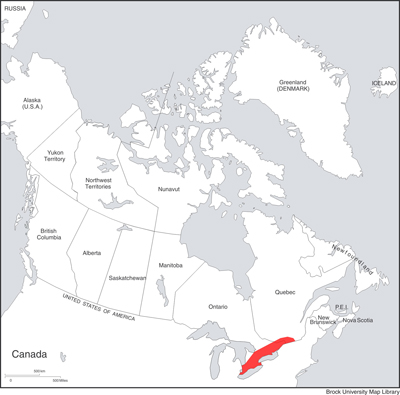
Megachile sculpturalis Female |
Megachile sculpturalis Male |
Megachile sculpturalis Smith, 1853. Cat. Hym. Brit. Mus. 1: 181 (♀).
Diagnosis.The large size (19-25 mm), striking yellowish-brown pubescence of the mesosoma, and darkened wings will distinguish both sexes of this species from all other Megachile in Canada. The female of M. sculpturalis has 4-dentate mandibles and lacks cutting edges in the mandibular interspaces. The male can also be recognized by the row of conspicuous black spatulate hairs along posterior margin of the front tarsomeres.
FEMALE: Length 21-25 mm.
Head:
Figure M2: Megachile sculpturalis female mandible |
1) compound eyes greatly divergent below; lateral ocelli very much nearer eyes than margin of vertex (1:2), and placed well below supraorbital line, 2) clypeus extremely short and thickened apically, the outer face little if any longer medially than the thickened edge, margin with distinct crenulations and tubercles that extend onto clypeal surface, with a distinctly raised impunctate median line extending across supraclypeal area to median ocellus, 3) mandibles 4-dentate, the 3rd tooth small and located medially between 2nd and 4th teeth, without cutting edges (Figure M2), 4) gena nearly twice as wide as compound eye (7:4), hind margin of gena with a distinct carina, 5) vertex with punctures fine and close to subrugose, becoming relatively coarse and more separated on gena above, larger and more irregular below, face below ocelli densely rugosopunctate, protuberant between antennae, punctures of supraclypeal area quite coarse and distinct but very close, clypeus with very fine, densely crowded punctures medially, these becoming coarse and more distinct laterally with shiny interspaces, 6) pubescence black on face and gena, short and dense in paraocular area, with a small linear series of yellowish brown hairs just above lateral edges of clypeus and on lower surface of gena, pubescence very short and sparse on gena above and on vertex, 7) F1 broader than long (3.5:2), shorter than pedicel and F2, which are quadrate, remaining flagellomeres slightly longer than broad (4:3.5), apical flagellomere almost twice as long as broad.
Mesosoma:
1) entirely covered with dense, yellowish-brown pubescence, longer on pleura and propodeal area, becoming shorter on mesoscutum, sparse on central disc, not at all concealing the surface beneath, 2) mesoscutum closely punctate to subrugose, punctures slightly separated (<1 pd) only in centre of disc, those of scutellum and axilla uniformly very close; pleura dull beneath the pubescence, very closely punctate above, becoming coarsely rugose below; propodeum somewhat smoother but dull, quite densely and finely punctate, triangle smooth and impunctate, surface dull, becoming coarsely striate at base, 3) all basitarsi somewhat shorter and narrower than their tibiae, 4) tegula reddish-brown, uniformly covered with exceedingly minute and rather close punctures, 5) wings darkened throughout, more so within marginal cell, veins brownish-black.
Metasoma:
1) elongate and parallel-sided, T2 and T3 deeply grooved across base, less so on T4 and T5, basal margin of grooves carinate, apical margin of terga depressed; T1 with pubescence concolourous with mesosoma, T2 with pale basal fascia arising from carinate rim, apical fascia whitish laterally but becoming dark medially, T3-T6 with apical fasciae black; discal pubescence entirely black, limited to basal area of terga; T6 with short, erect black pubescence; punctures on T1 fine and shallow, on T2 and T3 large and coarse, with large shiny interspaces, becoming finer apically, and subrugose basally, on T4 and T5 the punctures much finer than preceding terga, on T6 with punctures very fine and close throughout; T6 with apical margin rounded, 2) S6 rounded; S1 and S2 with golden scopal hairs, S3-S6 uniformly covered with black scopal hairs; punctures coarse and sparse on all sterna; apical margins somewhat depressed.
MALE: Length 19-22 mm.
Head:
1) compound eyes slightly diverging below; lateral ocelli much closer to eyes than margin of vertex (2:3), 2) clypeal margin beneath pubescence emarginated medially, with a prominent tubercle on either side of emargination, and emarginate lateral to these, 3) mandibles 3-dentate, lower process large, broadly truncate and densely pubescent, curved ventrally, 4) gena slightly broader than compound eye (6:5), with a large, shining and impunctate concavity below, lower margin of concavity produced to form a conspicuous ridge just below base of mandible, hind margin of gena carinate, outer margin of concavity with a row of dense, elongate black pubescence, 5) vertex with punctures coarse and close to subrugose, becoming coarser and more separated on gena above, larger and more irregular below; face below ocelli densely rugosopunctate, punctures of supraclypeal area very fine and distinct but very close, clypeus coarsely rugosopunctate, with shiny interspaces medially, 6) head with copious, erect, black pubescence on vertex, just below median ocellus, on paraocular area, and basally on clypeus, yellowish pubescence largely obscuring surface on supraclypeal area, with elongate downwardly directed yellow hairs apically on clypeus, gena with sparse yellowish-white pubescence along carinate rim becoming dense and elongate below along hypostomal carina and on lower edge of basal mandibular process, 7) F1 twice as broad as long, and subequal in length to pedicel, remaining flagellomeres much longer than F1 and pedicel combined, about twice as long as broad, apical flagellomere more elongate (4:1.5).
Mesosoma:
1) entirely covered with dense, yellowish-brown pubescence, longer on the pleura and propodeal area, becoming shorter on mesoscutum, sparse on central disc, not concealing the surface beneath, short and erect on legs with scattered black hairs on hind edge of front and mid tarsi, 2) punctures of mesoscutum fine and close, slightly separated only in centre, densely crowded otherwise, those of scutellum more coarse, punctures on axilla uniformly fine and close; pleura shiny, punctures rather coarse but close, becoming irregular ventrally; lateral faces of propodeum somewhat smoother, punctures shallow, fine and separated by >1 pd, triangle rather dull, impunctate, 3) front coxal spine wide and elongate, apical 1/3 curved anteriorly, with densely plumose, elongate yellow hairs on dorsal edge, anterior surface of coxa bare and somewhat shining with sparse punctures and short subappressed yellow hairs; mid tibial spur well developed; front tarsomeres reddish-brown and very slightly expanded, with a row of conspicuous black spatulate hairs along posterior margin, front basitarsus slightly excavated; mid and hind basitarsi slender and simple, largely dark, 4) tegula brownish-black, uniformly and closely covered with fine punctures, 5) wings darkened throughout, more so apically and within marginal cell, veins brownish-black.
Metasoma:
1) T2 and T3 deeply and widely grooved across base, less so on T4 and T5, basal margin of grooves on T2 and T3 carinate, apical margin of T2-T4 strongly depressed, less so on T5; pubescence of T1 concolourous with mesosoma, apical fascia of T2 whitish laterally but becoming dark medially, apical fasciae of remaining terga black; discal pubescence entirely black, confined almost entirely to basal depression; T5 and T6 with short, erect black pubescence; T1 with punctures fine and shallow, T2 and T3 with punctures large and coarse medially with large shiny interspaces, becoming finer and rugosopunctate apically, and subrugose basally; T4 with punctures much finer than preceding terga, T5 even more so with punctures of uniform size and spacing across tergum, T6 vertical in orientation, with punctures very fine and close throughout, carina slightly upturned, evenly rounded with a very slight median emargination, deep median depression basal to carina, 2) S1 finely and sparsely punctate basally, smooth and almost impunctate apically with broad hyaline margin, S2-S4 very coarsely and irregularly punctate laterally, becoming finer to rugose medially, S2 with broad, depressed yellowish-hyaline apical margin with fascia of pale hairs laterally, darkening medially, S3 and S4 depressed basally, S3 with apical margin less broad than preceding segment, that of S4 becoming wide medially, S1-S4 with a median patch of short, dense, erect pubescence.
Genitalia: Figure G2.
|
Figure G2: Megachile sculpturalis genitalia |
Discussion:
An adventive species first observed in Canada in 2002 (Magnum and Sumner 2003; Paiero and Buck 2003) and the only member of subgenus Callomegachile in North America (Michener 2007). This species was first reported in North America by Magnum and Brooks (1997). Like members of the subgenera Chelostomoides and Pseudomegachile (see below), this species uses plant resins instead of cut leaf pieces for nest construction. This species nests in cavities in wood (Table 1).
Distribution:
This species has been collected in southern ON (Toronto, Guelph) and Montreal, QC (Gibbs and Sheffield 2009), but is expected to spread throughout southern Canada (Hinojosa-Díaz et al. 2005) (see Map 2).
|
Map 2: Canadian distribution of Megachile sculpturalis |

